Madho Singh Bhandari
Shri Madho Singh Bhandari | |
|---|---|
 | |
| Born | c. 1585 c. Maletha, Tehri-Garhwal, Uttarakhand |
| Died | c. 1640 c. Chotta Chini, Tibet (present-day China) |
| Allegiance | Kingdom of Garhwal |
| Branch | Garhwali Army |
| Years of service | c. 1600–1640 |
| Rank | General Commander |
| Battles / wars | Battle of Chotta Chini (c. 1635–1640) Campaigns against Tibet and |
| Awards | Folk hero status; subject of Pawara ballads |
| Other work | Administrator, builder of Maletha Canal |
Madho Singh Bhandari (c. 1585 – c. 1640) was a prominent warrior, military general, and administrator in the Kingdom of Garhwal during the reign of King Mahipat Shah in the 17th century.[1][2] He is celebrated in Garhwali folklore for his military bravery, infrastructural contributions, and ultimate sacrifice during the construction of the Maletha Canal.
Early life
Madho Singh Bhandari was born around 1585 CE in Maletha, a village in the present-day Tehri-Garhwal district of Uttarakhand, India.[1] His family belonged to a respected warrior lineage and served the Garhwali kings for generations. From an early age, he was trained in martial arts, horse riding, and warfare strategy.
Military career
During the reign of King Mahipat Shah (r. c. 1620–1640), Bhandari emerged as one of the three most prominent generals of Garhwal, alongside Rikhola Lodi and Banwari Dass.[3] His period of activity coincided with campaigns against Tibet, Sirmour, and the southern frontiers of Garhwal.[4]
A well-known Garhwali saying encapsulates his legendary status: "Ek Singh desh ran, ek Singh gaay ka, ek Singh Madho Singh aur Singh kaaye ka" — meaning "One Singh in the battlefield, one Singh (horn) of a cow, and one Singh Madho Singh."[3]
Battle of Chotta Chini
Bhandari is believed to have died in the Battle of Chotta Chini in Tibet, sometime between 1635 and 1640 CE.[4] According to tradition, he was fatally wounded in battle when Garhwali forces were in disarray. To prevent his death from demoralizing the troops, he ordered his men to roast his body and display it on horseback so that the enemy would believe he was still alive. This stratagem reportedly caused the Tibetans to retreat, thinking he remained in command. His bravery is immortalized in the Pawara ballads sung in Garhwal.[5]
Maletha Canal
Bhandari is also renowned for his role in constructing the Maletha Canal, a 2-kilometre-long irrigation channel from the Takoli Gad to Maletha village.[6][7] Built in the 17th century, the canal includes a 600-metre tunnel carved through hard rock. Local tradition holds that he sacrificed his own son to propitiate a goddess and ensure the canal's successful completion. This act is considered one of the greatest sacrifices in the history of Himalayan public works.
Legacy
Madho Singh Bhandari remains one of the most celebrated figures in Garhwali history. His military exploits, infrastructural achievements, and self-sacrifice have inspired folk songs, particularly the chivalric Pawara ballads.[3] In Uttarakhand, his name is invoked as a symbol of bravery, leadership, and devotion to public welfare.
References
- ^ a b Bhakt Darshan. गढ़वाल की दिवंगत विभूतियां (in Hindi). pp. 152–160.
- ^ Chandola, Khemanand (1987). Across the Himalayas Through the Ages: A Study of Relations Between Central Himalayas and Western Tibet. Patriot Publishers. p. 31. ISBN 978-81-7050-042-1.
- ^ a b c Garhwal Himalaya. Mittal Publications. 1993. p. 27. ISBN 9788170994376.
{{cite book}}: Check|isbn=value: checksum (help) - ^ a b Garhwal Himalaya. Mittal Publications. 1993. p. 41. ISBN 9788170994376.
{{cite book}}: Check|isbn=value: checksum (help) - ^ Rawat, Ajay Singh (1989). History of Garhwal, 1358-1947: An Erstwhile Kingdom in the Himalayas. Indus Publishing Company. ISBN 978-81-85182-18-6.
- ^ The Holy Himalaya. p. 172.
- ^ Nand, Nitya; Kumar, Kamlesh (1989). The Holy Himalaya: A Geographical Interpretation of Garhwal. Daya Publishing House. p. 172. ISBN 978-81-7035-055-2.